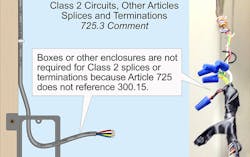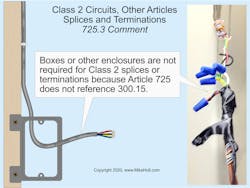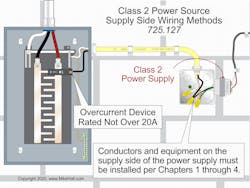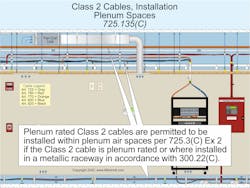Article 725 provides the requirements for Class 2 circuits in Part III. The definitions for Class 2 circuits can be found in Art. 100. In the November 2020 issue, we discussed the general requirements that apply to Class 1, 2, and 3 circuits. Some general requirements in Part I of Art. 725 apply to Class 2 but not Class 1. These are in Sec. 725.3:
- (L) Where installed in corrosive, damp, or wet locations, Class 2 cables must be identified for the location per Sec. 110.11 and Sec. 310.10(F). Conductors and cables installed in underground raceways [Sec. 300.5(B)], or in raceways aboveground in wet locations [Sec. 300.9], must be identified for wet locations. Where corrosion may occur, follow Sec. 300.6.
- (M) Class 2 cables can be installed in cable routing assemblies selected per Table 800.154(c), listed per Sec. 800.182, and installed per Sec. 800.110(C) and Sec. 800.113.
- (N) Class 2 cables can be installed in communications raceways selected per Table 800.154(b), listed per Sec. 800.182, and installed per Sec. 800.113 and Sec. 362.24 through Sec. 362.56, where the requirements applicable to electrical nonmetallic tubing apply.
- (O) The conductor temperature limitation requirements in Sec. 310.14(A)(3) apply to Class 2 cables.
Enclosures are not required for Class 2 splices or terminations because Art. 725 does not reference Sec. 300.15, which contains those requirements [Sec. 725.3] (Fig. 1).
What’s the class?
The circuit is that part between the power supply and the load, and the Class of that circuit depends on the power supply characteristics.
The power supply for a Class 2 circuit must be one of these [Sec. 725.121(A)]:
- A listed Class 2 transformer.
- A listed Class 2 power supply.
- Equipment listed as a Class 2 or 3 power source.
Exception No. 2 to (3): Where a circuit has an energy level at or below the limits established in Chapter 9, Table 11(A) and 11(B), the power supply does not have to be any of these three.
Or it can be one of these:
- Listed Audio/video information technology equipment, communications, or industrial equipment limited-power circuits [Sec. 725.121(A)(4)].
- A battery source or system listed and identified as Class 2 [Sec. 725.121(A)(5)] (Class 2 only).
Marking
Each power source must have a label indicating the maximum voltage and rated current output per conductor for each connection point on the power source:
- Power-limited circuits in Sec. 725.121(A)(3).
- Power-limited circuits for listed audio/video equipment.
- Listed information technology equipment.
- Listed communications equipment.
- Listed industrial equipment in Sec. 725.121(A)(4).
Where multiple connection points have the same rating, you can use one label [Sec. 725.121(C)].
Equipment supplying Class 2 circuits must be durably marked to indicate each circuit that is Class 2 [Sec. 725.124].
Wiring Methods
On the supply side of the Class 2 power supply, install conductors and equipment per Chapters 1 through 4. The overcurrent protection for Class 2 transformers or power supplies must not exceed 20A [Sec. 725.127] (Fig. 2).
One the load side, you can use:
- A Class 1 wiring method per Sec. 725.46 for Class 2 circuits [Sec. 725.130(A)]. Exception No. 2: Class 2 circuits can be reclassified as Class 1 if the Class 2 equipment markings are eliminated and the circuit is installed using a Chapter 3 wiring method per Sec. 725.46.
- Class 2 wiring of the type in Sec. 725.179 if installed per Sec. 725.133 and Sec. 725.154 [Sec. 725.130(B)].
Class 2 cables
Class 2 cables installed in buildings must be listed [Sec. 725.135(A)]. Table 725.154 describes how you can use them in buildings.
You can install plenum-rated Class 2 cables within plenum air spaces per Sec. 725.3(C), Exception No. 2, if the Class 2 are plenum-rated or installed in a metallic raceway per Sec. 300.22(C) [Sec. 725.135(C)] (Fig. 3).
In building locations other than those covered in Sec. 725.135(B) through (I), you can use only cables specified in Sec. 725.135(K). In one- and two-family dwelling units, you can use only cables specified in Sec. 725.135(M).
Separation
You can’t run Class 2 cables in any enclosure or raceway with power and Class 1 circuits, except as permitted in Sec. 725.136(B) through (I). For example, you can install Class 2 circuit conductors with power conductors and Class 1 conductors if separated by a barrier [Sec. 725.136(B)].
Class 2 circuit conductors can be in the same cable, cable routing assembly, enclosure, or raceway with other Class 2 circuit conductors [Sec. 725.139(A)].
Class 2 circuits can be in the same cables with conductors of communications circuits if the cable is listed communications cable that has been installed per Part V of Art. 805 [Sec. 725.139(D)(1)].
Class 2 cables can be in the same enclosure, cable tray, raceway, or cable routing assembly as jacketed cables of any of these [Sec. 725.139(E)]:
- Power-limited fire alarm circuits per Parts I and III of Art. 760.
- Nonconductive and conductive optical fiber cables per Parts I and IV of Art. 770.
- Communications circuits per Parts I and IV of Art. 805.
- Coaxial cables per Parts I and IV of Art. 820.
Audio output circuits [Sec. 640.9(C)] using Class 2 wiring methods per Sec. 725.133 and Sec. 725.154 cannot be installed in any cable routing assembly, raceway, or cable with Class 2 and Class 3 cables [Sec. 725.139(F)]. Audio circuits must use a Class 2 wiring method when required by Sec. 640.9(C); however, these circuits are not Class 2 circuits.
Support
Class 2 cables cannot be strapped, taped, or attached to any raceway as a means of support [Sec. 725.143]. Class 2 control cables can be supported by the raceway that supplies power to the equipment controlled by the Class 2 cable [Sec. 300.11(C)(2)].
Power and data transmission
Section 725.144 applies to Class 2 circuits that transmit power and data to a powered device. Section 300.11 and Parts I and III of Art. 725 apply to Class 2 circuits that transmit power and data. Conductors that carry power and data must be copper. The current cannot exceed the current limitation of the connectors.
Below Sec. 725.144, you will find six informational notes. For example, Note 3: “The requirements of Table 725.144 were derived for carrying power and data over 4-pair copper balanced twisted-pair cabling. This type of cabling is described in ANSI/TIA 568-C.2, Commercial Building Telecommunications Cabling Standard — Part 2: Balanced Twisted-Pair Telecommunications Cabling and Components.”
You’ll also find Table 725.144 Copper Conductor Ampacity in 4-Pair Class 2 Power/Data Cables with All Conductors Carrying Current. This table is not required for installations where conductors are 24 AWG or larger and the rated current per conductor of the power source does not exceed 0.30A [Sec. 725.144(A), Exception].
Cable Types CL2P-LP, CL2R-LP, or CL2-LP can supply power to equipment from a power source with a rated current per conductor up to the marked current limit located immediately following the suffix “-LP.” They can transmit data to the equipment [Sec. 725.144(B)].
If you bundle fewer than 193 LP cables and the selected ampacity of the cables per Table 725.144 exceeds the marked current limit of the cable, you can use the ampacity determined from the table. For ambient temperatures above 30°C, the correction factors of Table 310.15(B)(1) or Equation 310.15(B)(2) must apply. The Class 2-LP and Class 3-LP cables must comply with the following, as applicable:
- Cables with the suffix “-LP” can be installed in bundles, raceways, cable trays, communications raceways, and cable routing assemblies.
- Cables with the suffix “-LP” and a marked current limit must follow the substitution hierarchy of Table 725.154 and Figure 725.154(A) in the NEC for the cable type without the suffix “-LP” and without the marked current limit.
- System design is permitted by qualified persons under engineering supervision.
Characterize for class
To ensure success when using Class 1, 2, and 3 circuits, first characterize the power supply. That power supply will define the circuit. Thus, once you know the power supply characteristics, you will know which general requirements from Part I to apply and which requirements in either Part II (Class 1) or Part III (Class 2) to apply.
These materials are provided to us by Mike Holt Enterprises in Leesburg, Fla. To view Code training materials offered by this company, visit www.mikeholt.com/code.About the Author

Mike Holt
Mike Holt is the owner of Mike Holt Enterprises (www.MikeHolt.com), one of the largest electrical publishers in the United States. He earned a master's degree in the Business Administration Program (MBA) from the University of Miami. He earned his reputation as a National Electrical Code (NEC) expert by working his way up through the electrical trade. Formally a construction editor for two different trade publications, Mike started his career as an apprentice electrician and eventually became a master electrician, an electrical inspector, a contractor, and an educator. Mike has taught more than 1,000 classes on 30 different electrical-related subjects — ranging from alarm installations to exam preparation and voltage drop calculations. He continues to produce seminars, videos, books, and online training for the trade as well as contribute monthly Code content to EC&M magazine.




